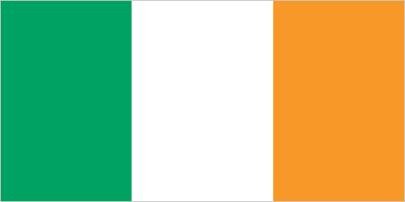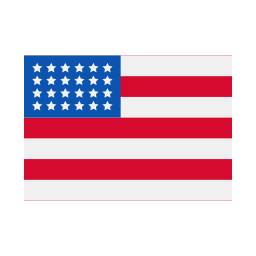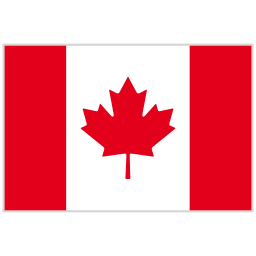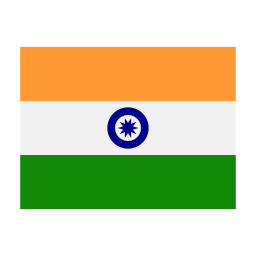IRELAND – GENERAL INFORMATION

GEOGRAPHY
Ireland is an island in Northwestern Europe in the North-Atlantic Ocean. The island lies on the European continental shelf, part of the Eurasian Plate. The island’s main geographical features include low central plains surrounded by coastal mountains. The highest peak is Carrauntoohil (Irish: CorránTuathai), which is
3,415 feet (1,041 m) above sea level. The western coastline is rugged, with many islands, peninsulas, headlands and bays. The island is bisected by the River Shannon, which at 224 miles (360.5 km) with a 63 mile (102.1 km) estuary is the longest river in Ireland and flows south from County Cavan in Ulster to meet the Atlantic just south of Limerick.
There are a number of sizeable lakes along Ireland’s rivers, of which Lough Neagh is the largest one. Ireland has a total area of 27,132 square miles (70,273 sq km). It shares one land boundary of 220 miles (360km) with the UK’s Northern Ireland. Its coastline has a length of 905 miles (1,448 km). Ireland, Iceland, and the UK dispute Denmark’s claim that the Faroe Islands’ continental shelf extends beyond 200 nm.
HISTORY

Celtic tribes arrived on the island between 600 and 150 B.C. Invasions by Norsemen that began in the late 8th century were finally ended when King Brian Boru defeated the Danes in 1014. Norman invasions began in the 12th century and set off more than seven centuries of Anglo-Irish struggle marked by fierce rebellions and harsh repressions. The Irish famine of the mid-19th century saw the population of the island drop by one third through starvation and emigration. For more than a century after that the population of the island continued to fall only to begin growing again in the 1960s. Over the last 50 years, Ireland’s high birthrate has made it demographically one of the youngest populations in the EU. The modern Irish state traces its origins to the failed 1916 Easter Monday Uprising that touched off several years of guerrilla warfare resulting in independence from the UK in 1921 for 26 southern counties; six northern (Ulster) counties remained part of the UK. Unresolved issues in Northern Ireland erupted into years of violence known as the “Troubles” that began in the 1960s. The Government of Ireland was part of a process along with the UK and US Governments that helped broker what is known as The Good Friday Agreement in Northern Ireland in 1998. This initiated a new phase of cooperation between the Irish and British Governments. Ireland was neutral in World War II and continues its policy of military neutrality. Ireland joined the European Community in 1973 and the euro-zone currency union in 1999. The economic boom years of the Celtic Tiger (1995-2007) saw rapid economic growth, which came to an abrupt end in 2008 with the meltdown of the Irish banking system. Today the economy is recovering, fueled by large and growing foreign direct investment, especially from US multi-nationals.
THE PEOPLE
The people of Northern Ireland hold various national identities; including Irish, Northern Irish, British, or some combination thereof.
The Irish have their own customs, language, music, dance, sports, cuisine, and mythology. Although Irish (Gaelic) was their main language in the past, today the huge majority of Irish people speak English as their first language. Historically, the Irish nation was made up of kin groups or clans, and the Irish also had their own religion, law code and style of dress.
There have been many notable Irish people throughout history. After Ireland’s conversion to Christianity, Irish missionaries and scholars exerted great influence on Western Europe, and the Irish came to be seen as a nation of “saints and scholars”. The 6th-century Irish monk and missionary Columbanus is regarded as one of the “fathers of Europe”, followed by saints Cillian and Fergal. By some accounts, the first European child born in North America had Irish descent on both sides. Many presidents of the United States have had some Irish ancestry.
The population of Ireland is about 6.3 million, but it is estimated that 50 to 80 million people around the world have Irish forebears; making the Irish diaspora one of the biggest of any nation.
SOCIAL CONVENTIONS
Most people in the country are Roman Catholic. Until the early 1990s the church had a very strong voice in society as well as politics. Their role however has diminished. There is now something of a generational divide with people over 50 still being quite observant and conservative in their views. Religion still very much has a say in society’s view of family, marriage, and abortion. The extended family is still very much the dominant social structure although urbanization is having an impact. Even when family members do move to the cities you will often find their ties to “home” are still very strong.
The Irish have a reputation for their wit and humor. As well as quick tongued with jokes they also make eloquent and witty speakers. They pride themselves on being able to find humor and it is often self-deprecating or ironic.
If you are teased, it is important to take it well and not see it as personal. They have a rich history in storytelling which was used to pass information down through the generations (poems and songs also served the same purpose).The basic greeting is a handshake and a hello or salutation appropriate for the time of day. Eye contact denotes trust and is maintained during a greeting. It is customary to shake hands with older children. Greetings tend to be warm and friendly and often turn into conversations.
If you are invited to an Irish home be on time.
The Irish appreciate modesty and can be suspicious of people who are loud and tend to brag. They dislike a superiority complex of any sort.
Communication styles vary from direct to indirect depending upon who is being spoken to. There is an overall cultural tendency for people to view politeness as more important than telling the absolute truth. This means that you may not easily receive a negative response. When you are being spoken to, listen closely. A great deal may be implied, beyond what is actually being said. For example, if someone becomes silent before agreeing, they have probably said “no”. They may also give a non-committal response. This may be due to the fact that the Gaelic language does
not have words for “yes” or “no”. There is a tendency to use understatement or indirect communication rather than say something that might be contentious. Generally speaking they do not like confrontation and prefer to avoid conflict, which they attempt to avoid by being humorous and showing good manners.
LANGUAGES
English (official, the language generally used), Irish (Gaelic or Gaeilge) (official, spoken mainly in areas along the western coast) (Gaelic or Irish Gaelic) is a Goidelic language of the Indo-European language family, originating in Ireland and historically spoken by the Irish. Irish is now spoken natively by a small minority of the Irish population – mostly in Gaeltacht areas – but also plays an important symbolic role in the life of the Irish state. It enjoys constitutional status as the first language.
GOVERNMENT
Ireland is a constitutional republic with a parliamentary system of government. The Oireachtas is the bicameral national parliament composed of the President of Ireland and the two Houses of the Oireachtas: Seanad Éireann (Senate) and Dáil Éireann (House of Representatives).
The President serves as head of state, and is elected for a seven-year term and may be re-elected once. The President is primarily a figurehead, but is entrusted with certain constitutional powers with the advice of the Council of State. The office has absolute discretion in some areas, such as referring a bill to the Supreme Court for a judgment on its constitutionality.
The Taoiseach (Prime Minister) serves as the head of government and is appointed by the President upon the nomination of the Dáil. Most Taoisigh have served as the leader of the political party that gains the most seats in national elections. It has become customary for coalitions to form a government, as there has not been a single-party government since 1989.
The Seanad is composed of sixty members, with eleven nominated by the Taoiseach, six elected by two universities, and 43 elected by public representatives from panels of candidates established on a vocational basis. The Dáil has 158 members (Teachtaí Dála) elected to represent multi-seat constituencies under the system of proportional representation and by means of the single transferable vote.
According to the Constitution of Ireland, parliamentary elections must be held at least every seven years, though a lower limit may be set by statute law.
Ireland has been a member state of the European Union since 1973, but has chosen to remain outside the Schengen Area. Citizens of the United Kingdom can freely enter the country without a passport due to the Common Travel Area, which is a passport-free zone comprising the islands of Ireland, Great Britain, the Isle of Man and the Channel Islands. However, some identification is required at airports and seaports.
TIME ZONE
UTC + 0
UTC + 1 (daylight savings time)
ELECTRICITY
230 Volt – plugs and sockets are same as in the UK.
CLIMATE
Ireland’s climate is mild, moist and changeable with abundant rainfall and a lack of temperature extremes. It is defined as a temperate oceanic climate. The country receives generally cool summers and mild winters. It is considerably warmer than other areas on its latitude, because it lies in the northeastern Atlantic Ocean, and as a result is warmed by the North Atlantic Current throughout the year.
As a small island downwind of a large ocean, the climate of Ireland is profoundly impacted by that ocean. The Atlantic current moves heat northwards, which is then carried by the prevailing winds towards Ireland.
The wind usually blows from the southwest, breaking on the high mountains of the west coast. Rainfall is therefore a particularly prominent part of western Irish life,
with Valentia Island, off the west coast of County Kerry, getting almost twice as much annual rainfall as Dublin on the east (55.1 in vs30.0 in).
January and February are the coldest months of the year, and mean daily air temperatures fall between 39.2 and 44.6 °F(4 and 7 °C) during these months. July and August are the warmest, with mean daily temperatures of 57.2 to 60.8 °F(14 to 16 °C), whilst mean daily maximums in July and August vary from 62.6 to 64.4 °F(17 to 18 °C) near the coast, to 66.2 to 68.0 °F(19 to 20 °C) inland. The sunniest months are May and June, with an average of five to seven hours sunshine per day. Though extreme weather events in Ireland are comparatively rare when compared with other countries on the European Continent, they do occur. Atlantic depressions, occurring mainly in the months of December, January and February, can occasionally bring winds of up to 99 mph (160 km/h) to Western coastal counties. During summer months, and particularly around late July/early August, thunderstorms can develop.
LOGISTICAL
Entry and Exit Requirements:
A Visa is not required for US and Canadian passport holders visiting for less than three months. Your passport must be valid through the duration of your stay. However, it is strongly suggested that your passport is valid at least six months after your planned return to your home.
Passports require one blank page.
Embassies:
US Embassy in Dublin
42 Elgin Rd.
Dublin 4
Ph (353)(1)668-8777
Canadian Embassy in Dublin
7 Wilton Terrace
Grand Canal Dock
Dublin 2
Ph (353)(1)234-4000
HEALTH
Medical services in Ireland are excellent. However, Hospitals in Ireland may not accept American insurance coverage. Patients are expected to pay all costs up-front at the time of treatment and apply for reimbursement from their own (travel) insurance later.
Ireland does not require vaccinations.
Information on vaccinations and other health precautions, such as safe food and water precautions and insect bite protection, may be obtained from the Centers for Disease Control and Prevention’s (CDC) hotline for international travelers at 1-800-CDC-INFO (1-800-232-4636) or via the CDC website at http://wwwnc.cdc.gov/travel. For information about outbreaks of infectious diseases abroad, consult the infectious diseases section of the World Health Organization (WHO) website at http://www.who.int/topics/infectious_ diseases/en/. The WHO website also contains additional health information for travelers, including detailed country-specific health information.
BANKS & CURRENCY
Ireland’s currency is the Euro. The currency restriction in entering or leaving Ireland is set at Euro 10,000.-
Generally banks are open between 10am and 4pm Monday through Friday.
Visas, Mastercard/Eurocard are very widely accepted in Ireland. All hotels, gas stations, supermarkets, shops/stores, pharmacies, restaurants, transport operators, payphones, etc will accept them.
American Express is accepted, but not nearly as readily as in the United States or Canada. Diners Club, JCB, Discover are generally not accepted. It is not advisable to rely on these cards as a sole method of payment while in Ireland.
COMMUNICATION
Ireland’s telecommunications network is a modern digital system that works the same as any Western country. To call a telephone number in Ireland from abroad, use your International dialing code plus the country code for Ireland (353). All Irish area codes begin with a “0” but for international calls, drop this leading zero.
Internet connection will work in most places with the exception of a few remote areas.
Cell Phone Usage:
Please contact your cell phone provider to determine whether your contract includes coverage in the country you are visiting. Depending on your contract you may have to add international services and/or country specific services.
country code – 353
ENTERTAINMENT
Bars and pubs are abundant and many play live Irish music and every town and city has a large choice of nightclubs. Ireland has many traditional and colorful festivals across the year, but the most famous is the St Patrick’s Festival held in every town in the country around St Patrick’s Day, March 17th. People dress in fancy green costumes and festivities include massive street parades, Irish music and street theatre. Ireland also has many parks and amusements to suit families. Dublin Zoo is set in a huge park and contains a vast array of different species. Ireland also has lots of amusement parks offering a wide variety of rides and fun attractions. The Tranmore-Waterford Park covers 20 hectares of land and has a miniature train ride, a boating lake and many other thrilling attractions.
Food & Drink
The Irish love eating out and there are a wide range of Michelin star restaurants as well as every conceivable type of international cuisine. Restaurants displaying the Feile Bia symbol represent those eateries, which produce excellent food from fine ingredients.
Shopping
Ireland’s reputation as a leading international shopping destination has also grown in the last 10 years. The capital Dublin, has a wide range of boutiques, but across the country shopping is good and you can also buy local crafts, its famous knitwear as well as superb crystal and glassware.
BAGGAGE
Baggage rules for international and domestic air travel have changed much in recent years, differ from carrier to carrier and these days even may cover your on-board bags. Checking luggage may cost a separate fee or may be free depending on your personal status with the carrier. We therefore encourage you to read your ticket’s small print and/or contact your carrier for exact rules.
TIPPING
About 10% is customary if you were satisfied with the service. Tour directors and coach drivers may be tipped based on $1.00 per person per day for the driver and $2.00 per person per day for the tour director (2017). If you travel on a private arrangement with a tour director performing well you may want to tip a bit more.
LAUNDRY
Laundry service is available at most hotels in the main centers. Generally you should allow about 24-hours before the item is returned to you, however, some have an emergency service available at an extra charge. Pack lightly and rather use such laundry services on a longer trip. It may in fact save you baggage fees with the airlines (see baggage).
PHOTOS & VIDEOS
In some countries you must refrain from photographing sites such as Military bases and industrial installations. Also be aware of cultural sensitivities when taking pictures of or near churches and other religious sites. It is always courteous to ask for permission before taking photographs of people.
USE OF DRONES
The use of drones is being legislated by many countries. In some cases drones are already forbidden and their unauthorized use may carry severe penalties. If you plan to travel with a drone please contact the embassy or consulate of the country you wish to visit.




